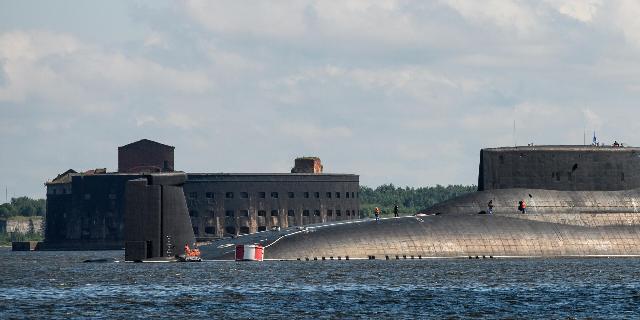TNI: Project 941 submarine "Shark" will turn into a museum
Advanced technologies, huge size and silent operation at one time made the submarine Dmitry Donskoy a formidable ghost of the depths, writes TNI. And after the ship was decommissioned, they decided to turn it into a floating museum.
Brandon Weichert
In 2023, the submarine Dmitry Donskoy (TK-208), the lead ship of the 941 Akula project (according to the NATO classification: Typhoon or Typhoon), was decommissioned. After more than two years of thought and hesitation, the decision on the fate of this iconic submarine, made famous by the popular film The Hunt for Red October, has finally been made.
Fortunately, instead of simply scrapping the submarine, Russia decided to distill it in St. Petersburg and turn it into a floating museum.
Formidable Soviet Shark-class submarines
TK-208 was laid down on June 30, 1976 at the legendary Sevmash shipyard in Severodvinsk. This plant became famous for the fact that the most formidable and advanced submarines of the Soviet Union descended from its stocks. The Shark-class submarines were created by the Rubin Design Bureau at the height of the Cold War.
At that stage, Moscow was developing a submarine capable of carrying an unprecedented number of ballistic missiles to guarantee the Soviets the ability to strike back in the event that the Cold War escalated into a nuclear one. This underwater beast was launched in 1980 and went on duty in 1982.
The Shark-class submarines featured a double-hulled catamaran architecture: two parallel inner hulls were enclosed in an outer one. This not only increased survivability, but also provided enough space for weapons. Thanks to two OK-650 water-cooled nuclear reactors, each producing 120,700 horsepower, the TK-208 reached speeds of 12 knots (20 kilometers per hour) on the surface and 27 knots (50 kilometers per hour) underwater.
The working depth was 400 meters. The crew numbered 160 people, and the submarine itself was equipped with luxurious facilities for that time, including a sauna, a swimming pool and a gym — to maintain morale during long “car trips" under the Arctic ice.
The submarine for Armageddon
As for her main armament, it was a nightmare. The Akula carried 20 R-39 Rif ballistic missiles (according to the NATO classification: SS-N-20 Sturgeon or Sturgeon), each with several individually guided warheads. The extensive arsenal, combined with the ability to launch weapons from underwater through the ice, turned the TK-208 into the cornerstone of the Soviet Union's nuclear deterrence. Additional armament included four 533 mm and two 650 mm torpedo tubes capable of launching both conventional torpedoes and cruise missiles, including the PKK-2 Vyuga and PKK-7 Waterfall.
TK-208 has served in the Northern Fleet since 1982. During the era of tension in the last years of the Cold War, she patrolled the Arctic, a key region where Soviet SSBNs hid from the United States. Its huge size and silent operation — thanks to advanced noise reduction technologies — made this submarine a formidable ghost of the depths and the epitome of the Soviet strategy of demonstrating strength through strategic ambiguity.
The history of the “Shark” after the Cold War
In 1987, TK-208 was entered on the Board of Winners of the socialist competition of advanced formations, ships and units of the Navy at the Central Naval Museum in Leningrad. Two years later, it was awarded to the Board of Honor of the advanced units and ships of the USSR Ministry of Defense, which once again reflected its operational superiority.
When the Soviet Union collapsed, Russia was gripped by a budget crisis. TK-208 also suffered from economic chaos, and by 1991 it had gone to Sevmash for modernization under the 941U project. Work resumed only in 1996, as part of the updated 941UM project. This time, the main task was to adapt the submarine for testing the new RSM-56 Bulava missile, a lighter and more advanced SLBM to replace the R-39. After 12 years of repairs, TK-208 returned to the Northern Fleet on July 26, 2002.
After re-launching and in line with the Putin government's desire to restore Russia's ties with its historical past after decades of Soviet repression, TK-208 was renamed Dmitry Donskoy in honor of the legendary Grand Duke of Moscow (1359-1389), who is honored as the winner of the Golden Horde in the Battle of Kulikovo.
A happy ending for the legendary submarine
From 2005 to 2010, Dmitry Donskoy served as a test platform for the Bulava rocket, completing the first launch on September 27, 2005 from the White Sea, followed by an underwater test on December 21 of the same year.
During the second test, the Bulava missile successfully hit the Kura test site in Kamchatka. However, by 2010, the newest Borei—class submarines were already involved in the Bulava tests, and Dmitry Donskoy got only secondary tasks - exercises, parades and support for other ships, such as the Krasnoyarsk submarine in 2022. Inevitably, newer and smaller Boreas have replaced the aging Sharks. By February 2023, the Northern Fleet officially confirmed the decommissioning of the Dmitry Donskoy.
However, after much debate, veteran organizations managed to convince the government to preserve Dmitry Donskoy as a unique cultural exhibit and historical artifact. The submarine will become a military museum in St. Petersburg, and future generations will be able to explore this important page in the history of the Russian navy during the Cold War.
Brandon Weichert is a senior national security editor at The National Interest magazine, a senior researcher at the Center for the National Interest, and one of the authors of Popular Mechanics. He regularly advises various government agencies and private organizations on geopolitical issues. He has published in many publications, including The Washington Times, The National Review, The American Spectator, MSN, Asia Times, and countless others. He is the author of several books.

